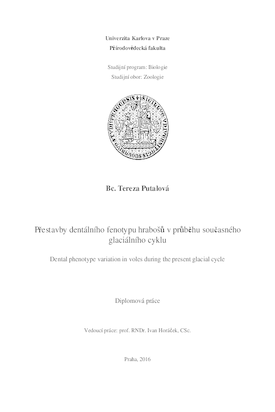Přestavby dentálního fenotypu hrabošů v průběhu současného glaciálního cyklu
Dental phenotype variation in voles during the present glacial cycle
diplomová práce (OBHÁJENO)

Zobrazit/
Trvalý odkaz
http://hdl.handle.net/20.500.11956/73775Identifikátory
SIS: 142739
Katalog UK: 990021058260106986
Kolekce
- Kvalifikační práce [20809]
Autor
Vedoucí práce
Oponent práce
Kuneš, Petr
Fakulta / součást
Přírodovědecká fakulta
Obor
Zoologie
Katedra / ústav / klinika
Katedra zoologie
Datum obhajoby
13. 9. 2016
Nakladatel
Univerzita Karlova, Přírodovědecká fakultaJazyk
Čeština
Známka
Velmi dobře
Klíčová slova (česky)
dentice, fenotypová proměnlivost, hraboši, morfometrika, glaciál, holocenKlíčová slova (anglicky)
dentition, phenotype variation, voles, morphometrics, glacial, HoloceneTechnikami detailní morfometrické analýzy byl zpracován rozsáhlý soubor dentálního materiálu hrabošů ze tří vrstevných sledů zachycujících poměry v závěru posledního glaciálu a v počátečních úsecích holocenu (35 - 8 ky B.P.). Hlavní pozornost byla věnována fosilnímu záznamu lokality Býčí skála, dokumentujícímu úsek dramatických přestaveb společenstev na hranici pleistocen/holocen (12,4-8,4 ky BP) s mimořádným rozlišením. Bylo ukázáno, že souběžně se změnami struktury společenstev dochází u všech sledovaných druhů hrabošovitých k různým přestavbám fenotypových charakteristik. Přes druhově specifické odlišnosti je obecným trendem radikální změna fenotypové dynamiky v závěru mladšího dryasu a na počátku preboreálu (11.7-11 kyBP). Neméně výrazný předěl fenotypového vývoje nastává pak v závěru preboreálu a počátkem boreálu, v úseku charakterisovaném nejvyšší intensitou změn ve složení společenstev a přestavbě environmentálních charakteristik. Druhy Clethrionomys glareolus, Microtus arvalis, M.agrestis a Arvicola terrestris, tvořící jádro společenstev preboreálního úseku, vykazují během preboreálu (ll-9,3 ky BP) výrazné fluktuace abundančních i fenotypových charakteristik související pravděpodobně s opakovanými invazemi genotypově odlišných populací. Klíčová slova: Paleontologie, evoluce, hraboši, zuby,...
The phenotype dynamics of arvicolid rodents during the terminal stages of the Vistualian glacial and the earliest Holocene was investigated with aid of a detailed morphometric analyses of extensive dental material from three sedimentary series of that age. The particular attention was paid to the record from a section in Býčí skála cave, Moravian karst, which demonstrated details of the Pleistocene/Holocene transition (12.4-8.4 ky BP) with extraordinary resolution. It revealed that dramatic rearrangements in community structure were accompanied by significant rearrangements of the phenotype dynamics in all arvicolid species. Despite some trends specific for particular species, some common features were identified as well. One of them was a rapid turnover in phenotype structure by the end of Younger Dryas, at time of the Preboreal event. (11.7-11 ky BP), the other was associated with the extensive shifts in community structure and habitat diversity at terminal stage of the Preboreal (9.7-9.3 ky). The core arvicolid species of Preboreal communities, Clethrionomys glareolus, Microtus arvalis, M.agrestis and Arvicola terrestris, exhibited repeated fluctuations during that stage (ll-9,3 ky BP) both in abundance and phenotype characteristics, supposedly related to serial invasion events during that time....
